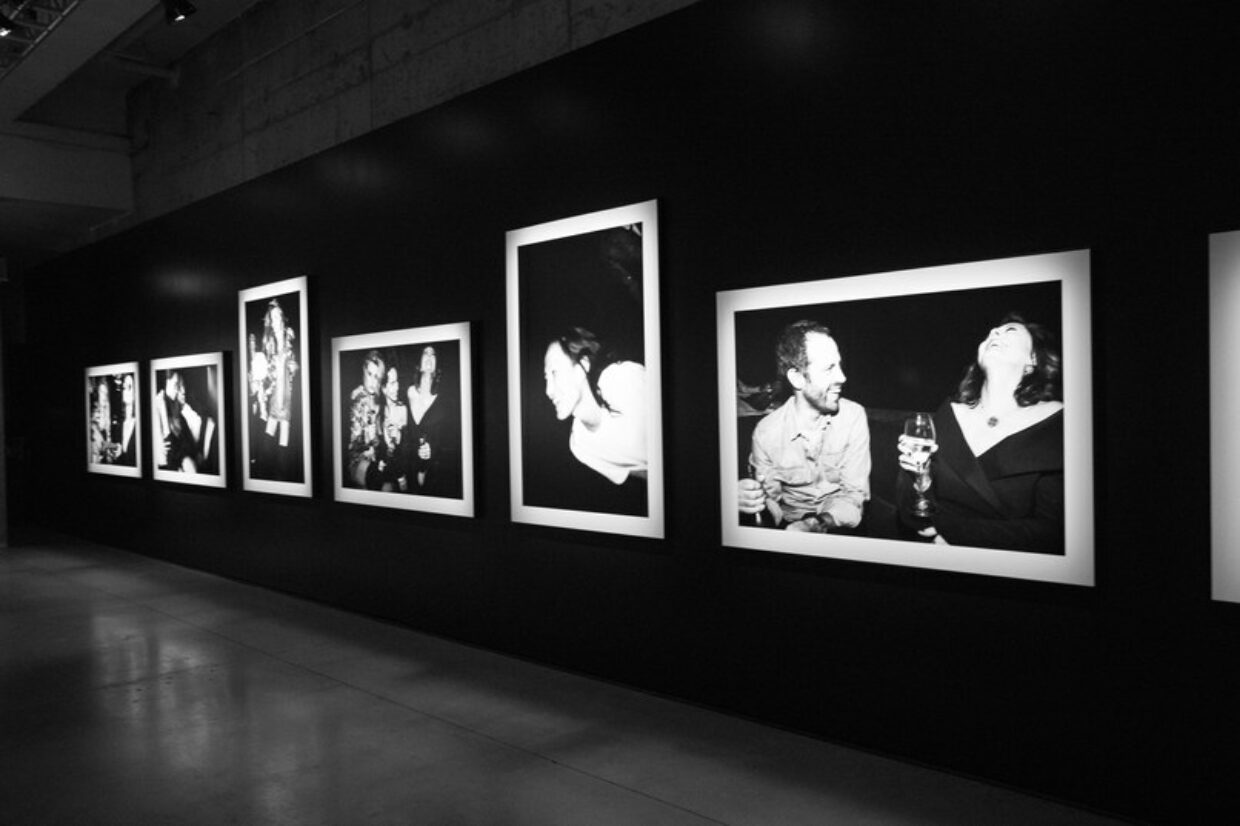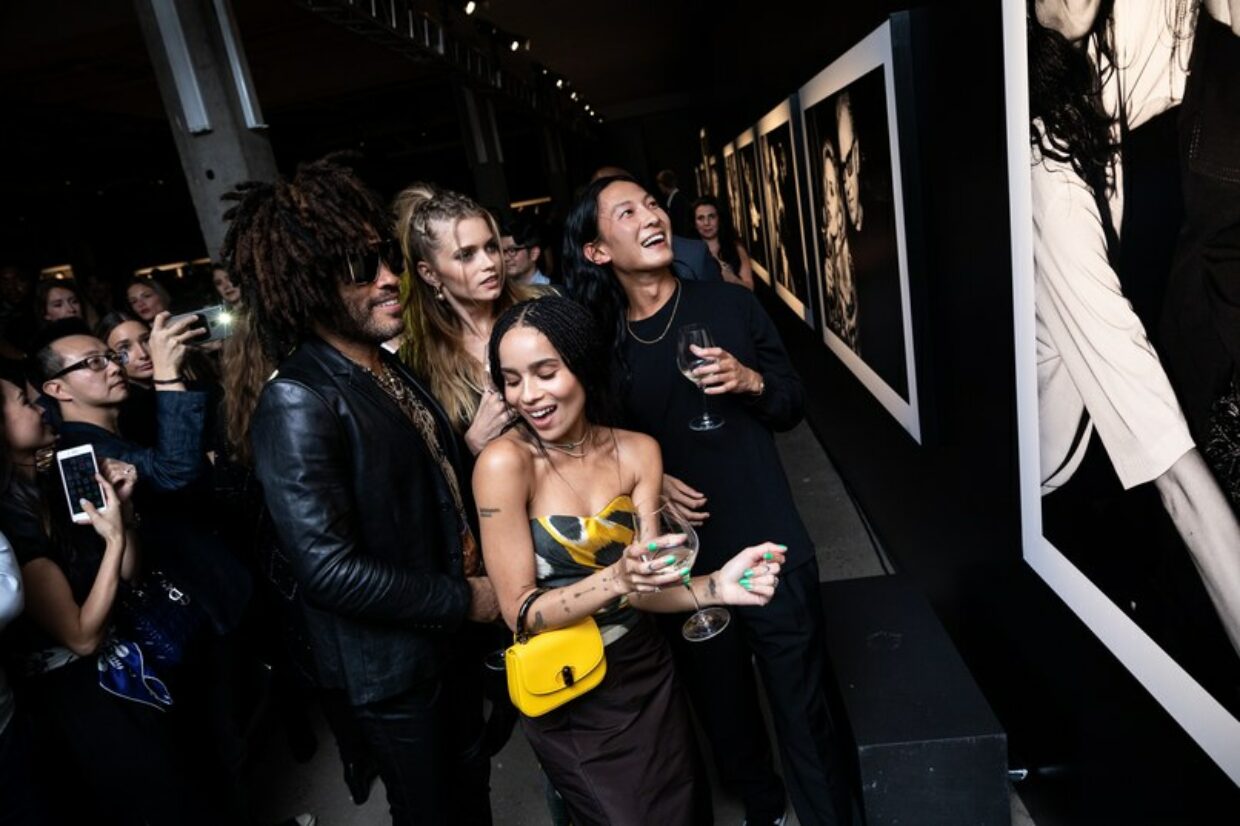Lenny Kravitz’s New Photography Project Started with a Dinner and Dance Party
Oct. 4, 2018
By: Christie Grimm
In the subterranean space at Skylight Modern hang the black-and-white mementos from a night hosting an eclectic group of creatives, including Zoë Kravitz, Alexander Wang, Susan Sarandon, Benjamin Millepied, and Harvey Keitel. But the project, entitled Assemblage, doesn’t just have celebrity subjects, but a celebrity creator as well. The works serve as a testament to not only Lenny Kravtiz’s photographic skills, but his entertaining and design expertise, as the images were shot at one of Kravitz Design’s Hollywood Hills homes, the Stanley House. The result: a brilliant exhibition of party snaps.
“I’m very grateful for everything that I’ve done, but I see it all as an education. I’m one that likes to have a nice, long, slow burn, so I feel like the work that will really define me is in front of me,” Kravitz, who put out his first home nearly 30 years ago, explains. A constant creative—from his music career and design firm, Kravitz Design, to his work as a photographer—his most recent, and perhaps most interesting role comes as creative director of Dom Perignon, an organic collaboration brought on through his years-long friendship with the house’s chef de cave, Richard Geoffroy.
Inspired by Ron Galella’s Studio 54 photographs, Assemblage is Kravitz’s first project for the champagne house, and will be on display through Saturday, October 6. Below, the multihyphenate tells us a little more about his ethos on design, his shared aesthetic between music and art, and how he stumbled into photography (and succeeded).
Architectural Digest: How did you get into photography?
Lenny Kravitz: I came to photography through my father. My father was a journalist—he worked at NBC News and he covered the Vietnam War. He came home with this Leica camera, and I used to play with it as a kid. I had no idea how to use it, but I was drawn to the camera itself. I thought it was very interesting, the design of it. Then later on in life, my father gave me the camera when I was 21. And when I was 24 I got a record deal and I began to have to be in front of the camera, which is all well and good, but I thought it was far more interesting what was going on behind the camera. And so I would start to talk to these photographers and they would invite me in their darkrooms to see the process. People like Mark Seliger, Jean-Baptiste Mondino. They would show me how the camera works. One day I just got the bug.
AD: Can you talk a little bit about Assemblage and how it came to be?
LK: For this project, I was very much inspired by this book of Studio 54 photographs by Ron Gallela, who shot all those wonderful shots of that New York nightlife. And so I wanted it to be natural lighting, inside, in the dark, with a flash. And we had a dinner party and a dance party, and by the end, everybody really knows each other now. It started off everybody standing around: ‘What are we gonna do, what is this?’ Because it can be stiff, a lot of them are actors, they’re still not comfortable showing up without a script. So we just started to hang out and talk. And my daughter was the catalyst. She got everybody to relax, everybody talking.
Whenever anybody has a party, no matter how big your house is, everyone’s in the kitchen. You could have 30 rooms, everyone’s in the kitchen. And so we started in the kitchen, cooking with them. And that began the photo session. But we moved to the dining table, we had a wonderful dinner party. And then we went downstairs to the club. Because we built a nightclub in the house. This is a house that Kravitz Design had just finished building in the Hollywood Hills called the Stanley House, which is sold now. But it was just a real evening of this eclectic group of artists hanging out, getting to know each other and talking.
AD: How did you come to work with Dom Perignon?
LK: Dom Perignon is a classic. There’s so many classics in life. This is something that’s been tried and proven and has made a name for itself and you expect a certain level of quality, at the highest level. And it’s also a name and an idea that when people think of Dom Perignon, they think of something very special, the quality will be at its highest, but it’s also something that you’re going to remember. You’re opening this bottle for a reason. I know people that drink quite often—they pull it out ’cause it’s Tuesday. And that’s wonderful. Because Tuesday is an occasion. Every day of life is an occasion. We’re not promised tomorrow. But it marks a time, an event, an occasion, and it’s an art form.
AD: Do you change anything in your home when you have people over versus when you’re not hosting?
LK: Lighting. I’m very sensitive to lighting and mood. And so I tend to like lighting very low. And then augment it with candlelight.
AD: What does a well-appointed bar look like to you?
LK: Everything is chosen. In my homes or the homes that I build, down to the screw, everything is chosen for a reason, for an aesthetic purpose. The glasses you might like—I won’t say which brands—but it’s all important. Every element is important: how something looks, how it feels in your hand, how it looks on the table, how it reflects light. Everything is thought about.
AD: Is there a shared aesthetic between music and art and design?
LK: I’ve learned that I’m just as passionate about music—music is the nucleus of my creative person—as design, photography, and even acting. But the beauty is that I like to be creative all the time. I wake up and I want to do something. So if I’m making music and I’m in the studio for weeks, and I’ve exhausted that, I can pay attention to my photography, and then I’ll go and shoot. And then I’ll exhaust that, and I’m always doing design, whether I’m on tour or doing photography, because the business doesn’t stop. So my team will fly out to wherever I am; we’ll do things via computer; I’ll make decisions over the phone. So I’m always weaving the different mediums and it enables me to be continually creative.
I started Kravitz Design and I went to the interiors and architecture lane because that was something that I was so interested in. I had no idea how I could make that happen, or how I would get into it, but I just basically took my own money and started the company. And lost a lot of it figuring it out! But it’s been wonderful, and I’ve been paying my dues. I got accepted into that world by spending time, going to Milan and going to these things and being with all these people and then Philippe Stark discovering me.
AD: What kind of art do you personally like to keep in your home?
LK: For my own stuff, it’s things that inspire me. I collect a lot of photography, and all the photography in my house are things that remind me of who I am, where I came from, my parents, my history. For instance going all the way up my stairs in Paris is a whole scene from civil rights. Lots of civil rights pictures. Interracial pictures—I come from an interracial background. And when I walk these stairs every day in my house, I give thanks because without the work of my ancestors and my family from the past few generations, I would not be. And I would not get to be who I am, I would not get to be in this home, have the things or opportunities that I have, because they sacrificed and gave their lives and worked so hard so that I could prosper. So it’s things that inspire me; people that inspire me.
Source: AD


